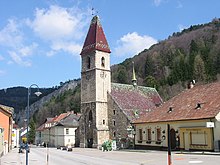Franz von Walsegg
Franz de Paula Anton Reichsgraf von Walsegg (also Wallsegg ) (born January 16, 1763 in Stuppach near Gloggnitz / Lower Austria , † November 11, 1827 in Stuppach) was an Austrian nobleman and landowner. He is best known today because he commissioned Wolfgang Amadeus Mozart to compose the Requiem (KV 626).
Life
Franz de Paula Anton von Walsegg was the son of Franz Anton Joseph Imperial Count von Walsegg (* January 24, 1733 in Vienna; † January 11, 1786 there ) and his wife Maria, born Countess of Lamberg - Sprinzenstein (* April 24, 1736 ; † January 13, 1782 ). He came from a wealthy family in southern Lower Austria, from whom Matthias Wägele von Walsegg took over the rule of Klamm in 1642 , which was given to him by Emperor Ferdinand III. was then awarded as "free own ". In 1716 the Trinity Column , donated by Johann Franz Anton von Walsegg as thanks for the end of the plague, was erected on Semmeringstrasse near Schottwien , and in the following year, 1717, the family was elevated to the rank of imperial count with the sergeant-major Johann Karl von Walsegg .


Franz de Paula Anton von Walsegg joined the Habsburg army in 1782 and was promoted to ensign in Infantry Regiment No. 24 in 1785. After his father's death in 1786, he became the owner of several manors, including Schottwien, Klamm, Stuppach, Pottschach, Ziegersberg and Tribuswinkel. He mainly operated in agriculture and forestry, as well as gypsum quarries in the Semmering area and gypsum works in Schottwien. These ventures brought him great wealth due to the great demand for stucco, which was probably made in Stuppach. Count Walsegg also owned a city palace in Vienna.
In 1787 Franz von Walsegg married Maria Anna Prenner Edlen von Flammberg (born September 15, 1770 in Unterfellabrunn ) and moved his main residence to Stuppach Castle .
As an enthusiastic music and theater lover who also tried his hand at composing, Franz von Walsegg organized private chamber music concerts for friends and acquaintances twice a week, in which he himself participated as a cellist and flutist. On Sundays he invited his guests to theater performances in which his wife and her sister also played.
Maria Anna Countess Walsegg, b. Prenner Edle von Flammberg, died on February 14, 1791 at the age of 20 at Stuppach Castle and was buried in the Walsegg family crypt in the parish church of St. Veit in Schottwien . After the death of his wife, Franz von Walsegg had a grave monument erected by Johann Martin Fischer based on a design by the architect Johann Benedikt Henrici on the left bank of the Schwarza in the Stuppacher Au. Also in 1791 he sold his city palace in Vienna to the wholesaler and drug supplier Franz Wilhelm Natorp.
On the first anniversary of his wife's death, Franz von Walsegg anonymously commissioned Wolfgang Amadeus Mozart to compose the Requiem (KV 626) through a middleman in order to pass it off as his own work. According to the report of the then teacher at the patronage school of Count in Klamm and later choir regent in Wiener Neustadt, Anton Herzog, Count Walsegg performed the piece under his name on December 14, 1793 in the Neukloster in Wiener Neustadt . Previously, the Requiem had already premiered on January 2, 1793 in the Jahn'schen Saal in Vienna without the knowledge of the Count.
Franz von Walsegg died on November 11, 1827 at Stuppach Castle, with which the dynasty of the Imperial Counts of Walsegg also died out. He was buried in the Walsegg family crypt in the parish church of St. Veit in Schottwien .
Franz von Walsegg is often referred to in Mozart literature as Walsegg-Stuppach , but Stuppach is only a property or place name ("auf Stuppach") and not an actual part of the name. This inauthentic name may be based on confusion with the name Wurmbrand-Stuppach .
literature
- Christian Fastl: Wallsegg (Walsegg), Franz de Paula Josef Anton Graf von. In: Oesterreichisches Musiklexikon . Online edition, Vienna 2002 ff., ISBN 3-7001-3077-5 ; Print edition: Volume 5, Verlag der Österreichischen Akademie der Wissenschaften, Vienna 2006, ISBN 3-7001-3067-8 .
- August Reisenbauer (Ed.): Graf Wallsegg and the Mozart Requiem. Exhibition catalog. Pathfinder Guild Wartenstein Gloggnitz, Gloggnitz 1991.
- Ernst Stranz (Ed.): Graf Wallsegg and the Mozart Requiem. Exhibition catalog. Pathfinder Guild Wartenstein Gloggnitz, Gloggnitz 2006
- Christoph Wolff : Mozart's Requiem. History, music, documents. With study score . Bärenreiter, Kassel 1991, 4th corr. Edition 2003, ISBN 3-7618-1242-6
Web links
Individual evidence
- ↑ a b c d e f g R. Müller: Wallsegg (Walsegg), Franz de Paula Gf. from. In: Austrian Biographical Lexicon 1815–1950 (ÖBL). Volume 15, Verlag der Österreichischen Akademie der Wissenschaften, Vienna 1957-2013, p. 467 f. (Direct links on p. 467 , p. 468 ).
- ↑ Constantin von Wurzbach : Walsegg, the counts of . In: Biographisches Lexikon des Kaiserthums Oesterreich . 53rd part. Imperial-Royal Court and State Printing Office, Vienna 1886, p. 8 ( digital copy ).
- ^ A b c Christian Fastl: Wallsegg (Walsegg), Franz de Paula Josef Anton Graf von. In: Oesterreichisches Musiklexikon . Online edition, Vienna 2002 ff., ISBN 3-7001-3077-5 ; Print edition: Volume 5, Verlag der Österreichischen Akademie der Wissenschaften, Vienna 2006, ISBN 3-7001-3067-8 .
| personal data | |
|---|---|
| SURNAME | Walsegg, Franz von |
| ALTERNATIVE NAMES | Walsegg, Franz de Paula Anton Reichsgraf von (full name); Walsegg, Franz Graf von; Wallsegg, Franz von |
| BRIEF DESCRIPTION | Austrian nobleman |
| DATE OF BIRTH | January 16, 1763 |
| PLACE OF BIRTH | Stuppach , Gloggnitz , Lower Austria |
| DATE OF DEATH | November 11, 1827 |
| Place of death | Stuppach , Gloggnitz , Lower Austria |
